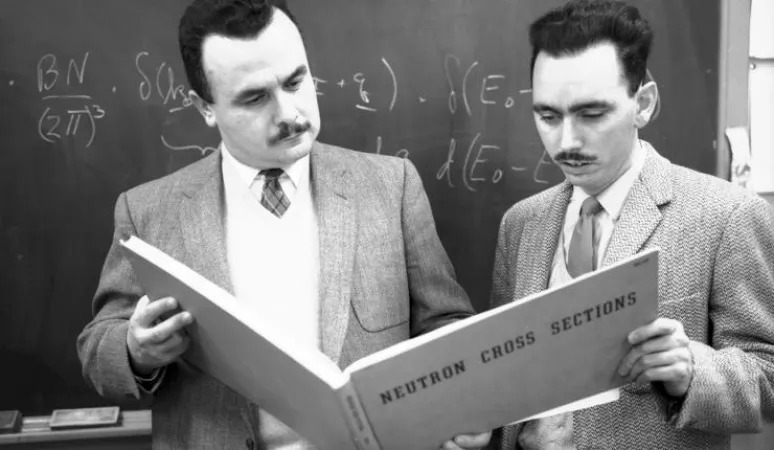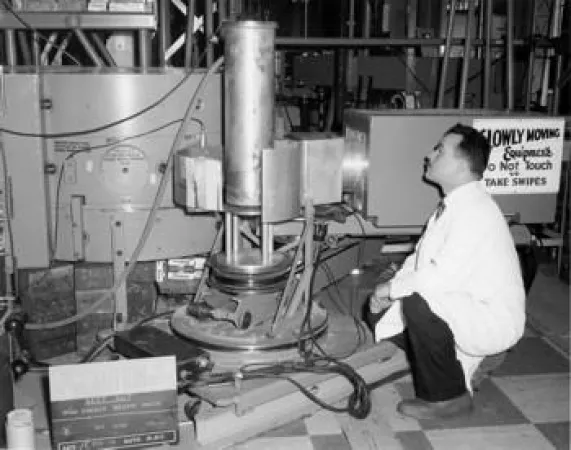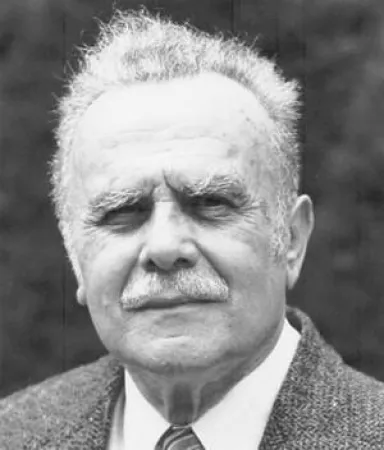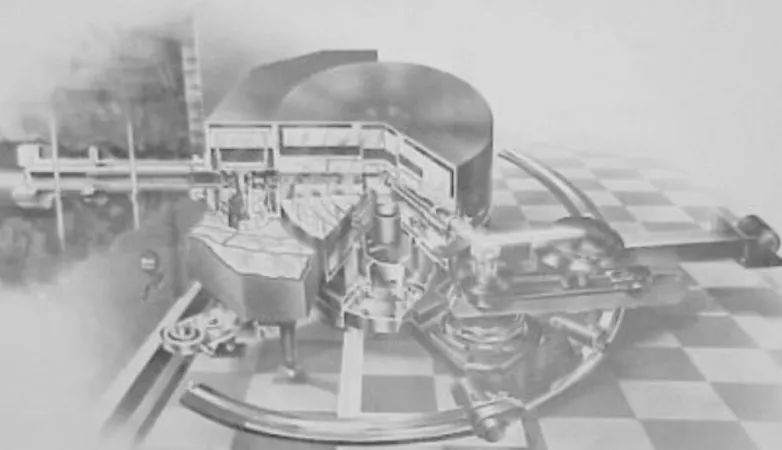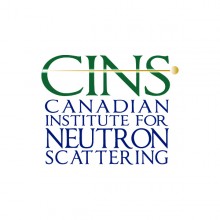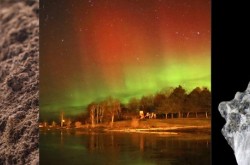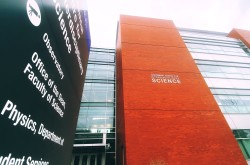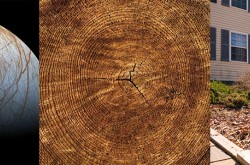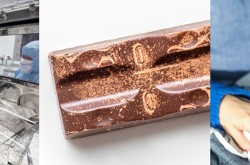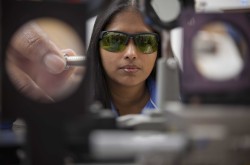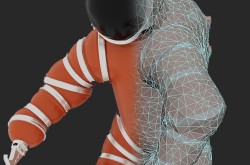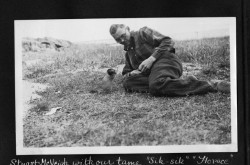Brockhouse and the Nobel Prize
This article was originally written and submitted as part of a Canada 150 Project, the Innovation Storybook, to crowdsource stories of Canadian innovation with partners across Canada. The content has since been migrated to Ingenium’s Channel, a digital hub featuring curated content related to science, technology and innovation.
The 1994 Nobel Prize in Physics was awarded to Bertram Brockhouse (Canada) and Clifford Shull (USA) who pioneered the use of neutron beams as tools for probing materials. The prize reflected the importance the scientific community places on these versatile and irreplaceable tools. Brockhouse’s methods have been replicated and further advanced at major neutron sources around the world. Today, neutron beams are in high demand by scientists and engineers globally for research.
The following article was written by Brockhouse’s first graduate students following his death in 2003.
Bertram Brockhouse, who shared the 1994 Nobel Prize in Physics for his brilliant, pioneering work which laid the foundation for the field of inelastic neutron scattering, died on 13 October 2003 in Hamilton, Ontario, Canada.
Bert, as he was known to his colleagues and friends, was born in Lethbridge, Alberta, Canada on 15 July 1918. His family moved to Vancouver when he was 8 and then to Chicago in 1935, by which time he had completed High School. In Chicago he worked as a lab assistant in a small electronic firm, took evening courses, and learned to design, build and repair radios, the latter giving rise to a small business. The family returned to Vancouver in 1938 and in September 1939 Bert enlisted in the Royal Canadian Navy. He spent some time at sea as an antisubmarine sonar operator but mostly serviced sonar equipment at a shore base. After completing a six month course in Electrical Engineering at Nova Scotia Technical College and becoming an Electrical Sub-Lieutenant, he was assigned to the test facilities at the National Research Council (NRC) in Ottawa, where he met his future wife, Doris (Dorie) Miller. After his discharge from the navy at the end of the war, he used support from a veteran’s program to enrol in a Physics and Mathematics program at the University of British Columbia, receiving his B.A. in 1947. After a summer job at NRC in Ottawa (when he became engaged to Dorie), Bert enrolled in graduate studies in Physics at the University of Toronto, receiving his M.A. in 1948 and his Ph.D. in 1950. His thesis was entitled “The Effect of Stress and Temperature upon the Magnetic Properties of Ferromagnetic Materials”. Bert and Dorie were married in 1948.
Near the end of his period at Toronto, Bert accepted an offer to join Donald Hurst’s neutron physics group at the Chalk River Nuclear Laboratories of NRC’s Atomic Energy Project (later to become, in 1952, Atomic Energy of Canada Limited, AECL), and he moved to Chalk River in 1950. Don Hurst effectively charged Bert with finding something interesting to do with neutron beams. He certainly did. Over the next dozen years, he played the dominant role in laying the foundation for the field of neutron inelastic scattering or, as he often preferred to call it, neutron spectroscopy, as later recognized by the Nobel Committee. Soon after arriving at Chalk River, Bert concluded that it might be feasible to measure the energy changes experienced by neutrons scattered by elementary excitations (phonons) using the National Research Experimental (NRX) reactor at Chalk River, then the most powerful research reactor in the world. If so, this would allow the dispersion curves for the phonon excitations to be determined, which in turn would yield information about the forces between atoms in samples and represent a major breakthrough in the fundamental understanding of condensed-matter systems. Realizing that the signal was going to be very weak, Bert and his scientific and technical collaborators set about developing/inventing techniques and instrumentation, including the improvement of all the components (monochromator crystals, detectors, filters, collimators, shielding, etc.) to make such measurements possible. Almost from the outset, Bert, always one to keep things simple, decided to employ single-crystal diffraction for neutron energy selection rather than the time-of-flight techniques being pursued by most of his competitors. This path led ultimately to two of his renowned achievements, the Triple-Axis Crystal Spectrometer (TACS) and the method of Constant-Q (constant momentum transfer), which have now been in widespread use for over four decades. The project was seriously delayed by the shutdown of the NRX reactor for over a year and a half in 1952-1954 but Bert benefited from a ten-month visit to Brookhaven National Laboratory during this period.
By the time NRX resumed operation, a primitive TACS was functioning and large metal (Al and Pb) monochromator crystals, which were much more efficient than the NaCl crystals used earlier, had been grown. Rapid progress was then made. At the January 1955 APS meeting, Bert was able to present preliminary but substantial results for the inelastic scattering by liquid and solid Pb, H2O, D2O, V and several paramagnetic materials. Later in 1955, he and Alec Stewart published the first convincing observation of a phonon dispersion curve, in a single crystal of Al, an unequivocal demonstration that short-wavelength phonon excitations existed in a metal. In 1955, following up on a proposal by Placzek and Van Hove in 1954, Bert also made the first determination of the frequency distribution of the normal modes in a material (V) from the incoherent one-phonon scattering. In addition to the TACS, Bert and his co-workers developed, used and continually improved other instruments, in particular a Be/ Pb Filter-Chopper spectrometer and a Rotating-Crystal spectrometer. By 1957, the TACS was fully developed, with all angles variable so that one could operate in the highly advantageous mode of fixed scattered energy. The Constant-Q method was invented in 1958, and by 1959 it was possible to program the spectrometer to scan in energy at pre-selected momentum transfers, normally along high-symmetry directions. By then Bert also had a new TACS installed at the recently commissioned and much more powerful National Research Universal (NRU) reactor, the world’s best research reactor for several years.
In 1957, Bert published the first dispersion relation for the quantized spin wave excitations (magnons) in a magnetic material (magnetite), with a follow-up study in an applied magnetic field in 1958 proving that the observed excitations were indeed in the spin system. The first material to be studied with the “programmable” TACS was Pb. The results showed that the interactions between the atoms were highly complex, and were sufficiently accurate to show, for the first time, “Kohn anomalies” arising from electron-phonon interactions, as had been predicted by Walter Kohn. Bert and his collaborators also made the first studies of phonons in semiconductors (Ge, Si) and alkali halides (NaI, KBr), the first observation of magnons in a metal (Co-8%Fe), and ground breaking studies of atomic motions in liquids (Pb, H2O, D2O). Their study on Na, where the forces were of short range, yielded the first phonon frequency distribution derived from dispersion curves. It clearly showed Van Hove critical points. The work on alkali halides, carried out with Dave Woods and Bill Cochran, led to Cochran’s famous shell model, of crucial importance for the understanding of materials with polarizable ions. The work on liquid Pb gave the self and pair correlation functions for the atoms. Work carried out much later showed that the quality of Bert’s results for water greatly surpassed that of other contemporary studies. In some cases the quality of his results was not surpassed for decades. Bert had a great passion for physics, an amazing physics intuition and an instinct for choosing good problems and the routes that would lead to solutions but, as he regularly emphasized, the terrific atmosphere for scientific research at Chalk River Labs as well as the outstanding technical support staff and facilities were essential ingredients of his success, as was having unlimited access to the best neutron sources of the day. Bert attracted visiting scientists from around the world to Chalk River Labs, as well as permanent staff (starting with Dave Woods, Gerald Dolling and Roger Cowley) for a group that has flourished to this day and is now again part of NRC.
Since about the time he started at Toronto, Bert had intended to eventually take up a University career and in 1962 he accepted a position as Professor of Physics at McMaster University in Hamilton, Ontario, moving there in September. The two of us, together with Sow-Hsin Chen of MIT, constituted his first group of graduate students. Although the field was becoming well established, thanks primarily to Bert’s work at Chalk River, it was only about seven years old in a form that current researchers would recognize and we still felt like pioneers, with Bert of course leading the way. Almost every measurement that one did was “a first”. Bert and his students built two new spectrometers at the McMaster Reactor (and later one at Chalk River as well) but much of our research was done on his TACS at Chalk River. Bert was insistent about good experimental technique. Before sending us off to Chalk River for our first serious experimental measurements, he called us together and told us that the worst sin that an experimentalist could commit was to get their data wrong. To take some weight from our young shoulders, he indicated that you wouldn’t be hanged if you messed up the interpretation. You had to do everything possible to eliminate or at least minimize all errors and uncertainties, and to estimate any that you couldn’t eliminate. It was this approach that had enabled him to pull out the very weak inelastic scattering signals in his early work at Chalk River, leading to the first convincing observations of phonon and magnon dispersion relations. Bert was also frugal with the taxpayer’s money and great at adapting unconventional objects to his needs. An anti-aircraft gun mount that he employed to first obtain variable incident energy with his TACS is still in use and, as graduate students, we used gun sights from the local war surplus shop as “goniometers” to align our samples. In total, eleven people obtained their Ph.D. degrees under Bert’s supervision and mentorship and several more obtained M.Sc. degrees. Bert taught graduate and undergraduate courses at McMaster, was chairman of the Physics Department 1967-1970, and played a key role in building up the Department’s research capacity. He retired in 1984, remaining Professor Emeritus thereafter.
The ultimate recognition of the importance of Bert’s work was the award of the 1994 Nobel Prize in Physics, which he shared with Clifford Shull of the Massachusetts Institute of Technology, Cliff having laid the foundation for the field of elastic neutron scattering. There were many other recognitions. Bert received the Buckley Prize of the American Physical Society (1962), the Duddel Medal and Prize of the Institute of Physics, U.K. (1963), the Tory Medal of the Royal Society of Canada (1963), the Medal for Achievement in Physics of the Canadian Association of Physicists (1967) and the Centennial Medal of Canada (1967). He was a Fellow of the Royal Societies of Canada and London, a foreign member of the Royal Swedish Academy of Sciences, and a Companion of the Order of Canada, Canada’s highest civilian award. He received Doctor of Science, Honoris Causa, degrees from the University of Waterloo and McMaster University.
At the very end of Bert’s period at Chalk River, the second International Atomic Energy Agency’s conference on Inelastic Scattering of Neutrons in Solids and Liquids was held at Chalk River Laboratories, 10-14 September 1962. Sixty-seven papers were given at this conference, and there were 64 participants from 13 countries. This represented a large fraction of all those who were, at that time, engaged in or interested in inelastic neutron scattering, and most of them were physicists. Today, well over 10,000 scientists and engineers, from essentially the full spectrum of disciplines, employ neutron scattering techniques to solve their problems, and their numbers are limited by the availability of neutron beams. It is very difficult for a young researcher of today to even imagine the hurdles that Bert and Cliff Shull faced and overcame to give the world neutron scattering, an immensely powerful technique for the study of condensed matter.
In addition to being one of the world’s great scientists, Bert Brockhouse was a fine person. He was a modest, unassuming individual of the highest integrity, always helpful, concerned and kind. His friends and colleagues will remember him as much for this as for his great intellect and scientific accomplishments. He was highly devoted to his family and leaves behind his wife of 55 years, Dorie, six children and ten grandchildren. His students were regularly invited to his home and Dorie, a truly wonderful person, has always been as much our friend as Bert. Although Bert was highly focussed on his research while at Chalk River, he took time to indulge in his life-long love of music and theatre, including taking part in amateur productions of three Gilbert and Sullivan operettas and a George Bernard Shaw play. He was known for bursting forth with excerpts from operettas and Broadway musicals while working on the spectrometers, and even when riding the late bus.
We had the amazing good fortune to work with Bert when he was at his peak, to benefit from his wisdom, guidance and example at the beginning of our careers, and to have enjoyed his friendship for over 40 years. He has been a constant inspiration to all those who worked with and knew him. We remember him with great affection, and we owe him a great debt of gratitude, as does the entire neutron scattering community and the scientific world at large.
E.C. Svensson
National Research Council of Canada
Chalk River Laboratories
J.M. Rowe
NIST Center for Neutron Research



